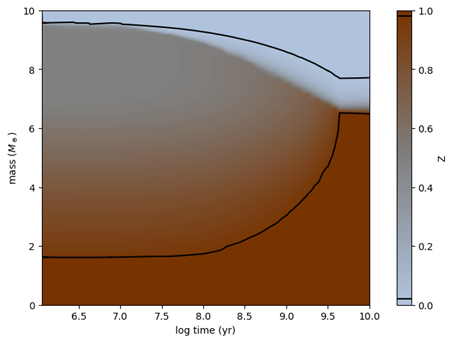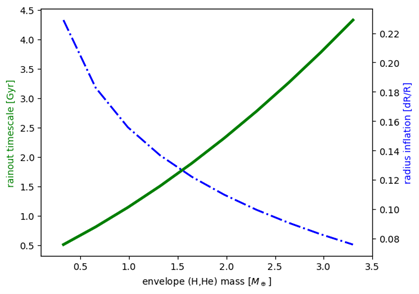Allona Vazan & Chris W. Ormel
Sub-Neptune planets formed in the protoplanetary disk accreted hydrogen-helium (H,He) envelopes. Planet formation models of sub-Neptunes formed by pebble accretion result in small rocky cores surrounded by polluted H,He envelopes, where most of the rock (silicate) is in vapor form at the end of the formation phase. This vapor is expected to condense and rain out as the planet cools. In this letter, we examine the timescale for the rainout and its e ect on the thermal evolution. We calculate the thermal and structural evolution of a 10 Earth masses planet formed by pebble accretion, considering material redistribution from silicate rainout (condensation and settling) and from convective mixing. We find that the duration of the rainout in sub-Neptunes is on an Gyr timescale and varies with envelope mass: planets with envelopes below 0.75 Earth mass rain out into a core-envelope structure in less than 1 Gyr, while planets in excess of 0.75 Earth mass of H,He preserve some of their envelope pollution for billions of years. The energy released by the rainout inflates the radius with respect to planets that start out from a plain core-envelope structure. This inflation would result in estimates of the H,He contents of observed exoplanets based on the standard core-envelope structure to be too high. We identify a number of planets in the exoplanet census where rainout processes may be at work, plausibly resulting in their H,He contents to be overestimated by up to a factor two. Future accurate age measurements by the PLATO mission may allow for the identification of planets formed with polluted envelopes.
Link to the publication in A&A Letters:
https://www.aanda.org/articles/aa/pdf/2023/08/aa46574-23.pdf

Silicate mass fraction (color) as a function of interior layers (y axis) and time (x axis). Silicate mass fraction ranges between zero (gas only) in blue and pure silicate in brown. The gradual distribution of silicate from formation converges into a core-envelope structure after about 4.25 Gyr. The solid lines signify Z = 0:98 and Z = 0:02 enrichment levels. Versions of this figure for radius and pressure layers instead of mass are presented in the letter in Appendix B.

Time from formation until convergence to a core-envelope structure (rainout timescale) as a function of envelope mass, shown in green. Trend is shown for sub-Neptune planets that contain 6.7 Earth masses of silicates and their gas (H,He) mass is determined by the mass loss rate, from 3.3 Earth masses down to 0.33 Earth masses. In blue, we show the maximum radius inflation by rainout in comparison to the core-envelope structure model at the rainout timescale. Curves are polynomial fits for the evolution data points.





